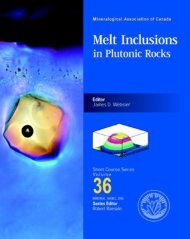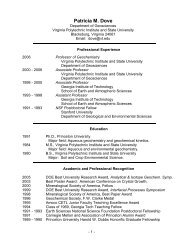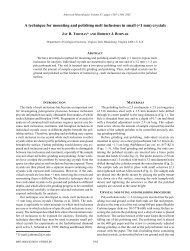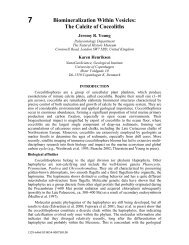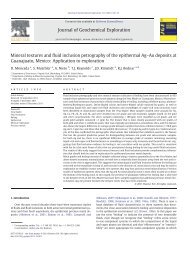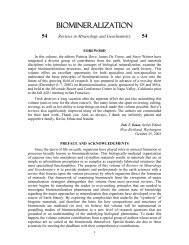Laser Ablation–ICP–MS in the Earth Sciences ... - Virginia Tech
Laser Ablation–ICP–MS in the Earth Sciences ... - Virginia Tech
Laser Ablation–ICP–MS in the Earth Sciences ... - Virginia Tech
Create successful ePaper yourself
Turn your PDF publications into a flip-book with our unique Google optimized e-Paper software.
APPENDIX: ANALYSIS MANAGEMENT SYSTEM (AMS)<br />
FIG. A5-7. Results w<strong>in</strong>dow show<strong>in</strong>g <strong>the</strong> composition of a fluid <strong>in</strong>clusion <strong>in</strong> quartz calculated with AMS. See text for<br />
description of each of <strong>the</strong> data columns.<br />
available as PDF, Excel, CSV or HTML files and/or<br />
<strong>in</strong> hard copy.<br />
The composition of <strong>the</strong> <strong>in</strong>clusion <strong>in</strong> this<br />
example calculated by AMS is 16.18 wt% NaCl,<br />
4.17 wt% CaCl2, 0.41 wt% KCl, and trace amounts<br />
of Mg, Al and Sr chlorides.<br />
MELT INCLUSION ANALYSIS AND DATA<br />
REDUCTION<br />
One of <strong>the</strong> major advantages of AMS is <strong>in</strong> <strong>the</strong><br />
<strong>in</strong>terpretation of laser ablation ICP–MS spectra for<br />
melt <strong>in</strong>clusions. If <strong>the</strong> melt <strong>in</strong>clusion is<br />
homogeneous (i.e., glassy) and exposed at <strong>the</strong><br />
surface <strong>the</strong>n <strong>the</strong> analysis and data reduction are<br />
straight forward and identical to <strong>the</strong> analysis of a<br />
solid phase. However, many melt <strong>in</strong>clusions are<br />
partly to completely crystallized and/or not exposed<br />
at <strong>the</strong> host crystal surface (Bodnar & Student 2006).<br />
In both cases it is necessary to use a laser spot that<br />
is somewhat larger than <strong>the</strong> melt <strong>in</strong>clusion, result<strong>in</strong>g<br />
323<br />
<strong>in</strong> a mixed signal that <strong>in</strong>cludes signal from <strong>the</strong> MI<br />
as well as from <strong>the</strong> host. The ma<strong>the</strong>matical process<br />
for separat<strong>in</strong>g <strong>the</strong> contributions of <strong>the</strong> MI and <strong>the</strong><br />
host is conducted with<strong>in</strong> AMS and requires no<br />
manual calculations.<br />
The example below outl<strong>in</strong>es <strong>the</strong> procedure for<br />
analyz<strong>in</strong>g a glassy melt <strong>in</strong>clusion that is not exposed<br />
at <strong>the</strong> crystal surface. The laser diameter was set<br />
slightly less than <strong>the</strong> MI diameter so that when <strong>the</strong><br />
laser ablated to <strong>the</strong> depth of <strong>the</strong> MI it would sample<br />
only MI material. As with analysis of fluid<br />
<strong>in</strong>clusions, <strong>the</strong> first step is to set <strong>the</strong> options <strong>in</strong> <strong>the</strong><br />
options w<strong>in</strong>dow. As described above for fluid<br />
<strong>in</strong>clusions, four analyses of <strong>the</strong> NIST 610 standard<br />
are used (two at <strong>the</strong> beg<strong>in</strong>n<strong>in</strong>g of <strong>the</strong> session and<br />
two at <strong>the</strong> end) and <strong>the</strong> host material phase analysis<br />
will be normalized to 100% oxides. If <strong>the</strong><br />
“Normalization to 100% oxides” option is selected,<br />
all elements that contribute significantly to <strong>the</strong><br />
composition of <strong>the</strong> host must be <strong>in</strong>cluded <strong>in</strong> <strong>the</strong> list



